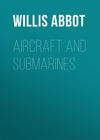Читать книгу: «Aircraft and Submarines», страница 3
For these reasons the development of the balloon lagged, until Count Zeppelin and M. Santos-Dumont consecrated their fortunes, their inventive minds, and their amazing courage to the task of perfecting a dirigible. In a book, necessarily packed with information concerning the rapid development of aircraft which began in the last decade of the nineteenth century and was enormously stimulated during the war of all the world, the long series of early experiments with balloons must be passed over hastily. Though interesting historically these experiments were futile. Beyond having discovered what could not be done with a balloon the practitioners of that form of aeronautics were little further along in 1898 when Count Zeppelin came along with the first plan for a rigid dirigible than they were when Blanchard in 1786, seizing a favourable gale drifted across the English Channel to the French shore, together with Dr. Jefferies, an American. It was just 124 years later that Bleriot, a Frenchman, made the crossing in an airplane independently of favouring winds. It had taken a century and a quarter to attain this independence.
In a vague way the earliest balloonists recognized that power, independent of wind, was necessary to give balloons steerage way and direction. Steam was in its infancy during the early days of ballooning, but the efforts to devise some sort of an engine light enough to be carried into the air were untiring. Within a year after the experiments of the Montgolfier brothers, the suggestion was made that the explosion of small quantities of gun-cotton and the expulsion of the resulting gases might be utilized in some fashion to operate propelling machinery. Though the suggestion was not developed to any useful point it was of interest as forecasting the fundamental idea of the gas engines of to-day which have made aviation possible – that is, the creation of power by a series of explosions within the motor.
In the effort to make balloons dirigible one of the first steps was to change the form from the spherical or pear-shaped bag to a cylindrical, or cigar-shape. This device was adopted by the brothers Robert in France as early as 1784. Their balloon further had a double skin or envelope, its purpose being partly to save the gas which percolated through the inner skin, partly to maintain the rigidity of the structure. As gas escapes from an ordinary balloon it becomes flabby, and can be driven through the air only with extreme difficulty. In the balloon of the Robert brothers air could from time to time be pumped into the space between the two skins, keeping the outer envelope always fully distended and rigid. In later years this idea has been modified by incorporating in the envelope one large or a number of smaller balloons or "balloonets," into which air may be pumped as needed.
The shape too has come to approximate that of a fish rather than a bird, in the case of balloons at least. "The head of a cod and the tail of a mackerel," was the way Marey-Monge, the French aeronaut described it. Though most apparent in dirigible balloons, this will be seen to be the favourite design for airplanes if the wings be stripped off, and the body and tail alone considered. Complete, these machines are not unlike a flying fish.
In England, Sir George Cayley, as early as 1810 studied and wrote largely on the subject of dirigibles but, though the English call him the "father of British aeronautics," his work seems to have been rather theoretical than practical. He did indeed demonstrate mathematically that no lifting power existed that would support the cumbrous steam-engine of that date, and tried to solve this dilemma by devising a gas engine, and an explosive engine. With one of the latter, driven by a series of explosions of gunpowder, each in a separate cell set off by a detonator, he equipped a flying machine which attained a sufficient height to frighten Cayley's coachman, whom he had persuaded to act as pilot. The rather unwilling aviator, fearing a loftier flight, jumped out and broke his leg. Though by virtue of this martyrdom his name should surely have descended to fame with that of Cayley it has been lost, together with all record of any later performances of the machine, which unquestionably embodied some of the basic principles of our modern aircraft, though it antedated the first of these by nearly a century.
We may pass over hastily some of the later experiments with dirigibles that failed. In 1834 the Count de Lennox built an airship 130 feet long to be driven by oars worked by man power. When the crowd that gathered to watch the ascent found that the machine was too heavy to ascend even without the men, they expressed their lively contempt for the inventor by tearing his clothes to tatters and smashing his luckless airship. In 1852, another Frenchman, Henry Giffard, built a cigar-shaped balloon 150 feet long by 40 feet in diameter, driven by steam. The engine weighed three hundred pounds and generated about 3 H. – P. – about 1/200 as much power as a gas engine of equal weight would produce. Even with this slender power, however, Giffard attained a speed, independent of the wind, of from five to seven miles an hour – enough at least for steerage way. This was really the first practical demonstration of the possibilities of the mechanical propulsion of balloons. Several adaptations of the Giffard idea followed, and in 1883 Renard and Krebs, in a fusiform ship, driven by an electric motor, attained a speed of fifteen miles an hour. By this time inventive genius in all countries – save the United States which lagged in interest in dirigibles – was stimulated. Germany and France became the great protagonists in the struggle for precedence and in the struggle two figures stand out with commanding prominence – the Count von Zeppelin and Santos-Dumont, a young Brazilian resident in Paris who without official countenance consecrated his fortune to, and risked his life in, the service of aviation.
CHAPTER III
THE SERVICES OF SANTOS-DUMONT
In his book My Airships the distinguished aviator A. Santos-Dumont tells this story of the ambition of his youth and its realization in later days:
I cannot say at what age I made my first kites, but I remember how my comrades used to tease me at our game of "pigeon flies." All the children gather round a table and the leader calls out "Pigeon Flies! Hen flies! Crow flies! Bee flies!" and so on; and at each call we were supposed to raise our fingers. Sometimes, however, he would call out "Dog flies! Fox flies!" or some other like impossibility to catch us. If any one raised a finger then he was made to pay a forfeit. Now my playmates never failed to wink and smile mockingly at me when one of them called "Man flies!" for at the word I would always raise my finger very high, as a sign of absolute conviction, and I refused with energy to pay the forfeit. The more they laughed at me the happier I was, hoping that some day the laugh would be on my side.
Among the thousands of letters which I received after winning the Deutsch prize (a prize offered in 1901 for sailing around the Eiffel Tower) there was one that gave me peculiar pleasure. I quote from it as a matter of curiosity:
"Do you remember, my dear Alberto, when we played together 'Pigeon Flies!'? It came back to me suddenly when the news of your success reached Rio. 'Man flies!' old fellow! You were right to raise your finger, and you have just proved it by flying round the Eiffel Tower.
"They play the old game now more than ever at home; but the name has been changed, and the rules modified since October 19, 1901. They call it now 'Man flies!' and he who does not raise his finger at the word pays the forfeit."
The story of Santos-Dumont affords a curious instance of a boy being obsessed by an idea which as a man he carried to its successful fruition. It offers also evidence of the service that may accrue to society from the devotion of a dilettante to what people may call a "fad," but what is in fact the germ of a great idea needing only an enthusiast with enthusiasm, brains, and money for its development. Because the efforts of Santos-Dumont always smacked of the amateur he has been denied his real place in the history of aeronautics, which is that of a fearless innovator, and a devoted worker in the cause.
Born on one of those great coffee plantations of Brazil, where all is done by machinery that possibly can be, Santos-Dumont early developed a passion for mechanics. In childhood he made toy airplanes. He confesses that his favourite author was Jules Verne, that literary idol of boyhood, who while writing books as wildly imaginative as any dime tale of redskins, or nickel novel of the doings of "Nick Carter" had none the less the spirit of prophecy that led him to forecast the submarine, the automobile, and the navigation of the air. At fifteen Santos-Dumont saw his first balloon and marked the day with red.
I too desired to go ballooning [he writes]. In the long sun-bathed Brazilian afternoons, when the hum of insects, punctuated by the far-off cry of some bird lulled me, I would lie in the shade of the veranda and gaze into the fair sky of Brazil where the birds fly so high and soar with such ease on their great outstretched wings; where the clouds mount so gaily in the pure light of day, and you have only to raise your eyes to fall in love with space and freedom. So, musing on the exploration of the aërial ocean, I, too, devised airships and flying-machines in my imagination.
From dreaming, the boy's ambitions rapidly developed into actions. Good South Americans, whatever the practice of their northern neighbours, do not wait to die before going to Paris. At the age of eighteen the youth found himself in the capital of the world. To his amazement he found that the science of aeronautics, such as it was, had stopped with Giffard's work in 1852. No dirigible was to be heard of in all Paris. The antiquated gas ball was the only way to approach the upper air. When the boy tried to arrange for an ascension the balloonist he consulted put so unconscionable a price on one ascent that he bought an automobile instead – one of the first made, for this was in 1891 – and with it returned to Brazil. It was not until six years later that, his ambition newly fired by reading of Andrée's plans for reaching the Pole in a balloon, Santos-Dumont took up anew his ambition to become an aviator. His own account of his first ascent does not bear precisely the hall-mark of the enthusiast too rapt in ecstasy to think of common things. "I had brought up," he notes gravely, "a substantial lunch of hard-boiled eggs, cold roast beef and chicken, cheese, ice cream, fruits and cakes, champagne, coffee, and chartreuse!"
The balloon with its intrepid voyagers nevertheless returned to earth in safety.
A picturesque figure, an habitué of the clubs and an eager sportsman, Santos-Dumont at once won the liking of the French people, and attracted attention wherever people gave thought to aviation. Liberal in expenditure of money, and utterly fearless in exposing his life, he pushed his experiments for the development of a true dirigible tirelessly. Perhaps his major fault was that he learned but slowly from the experiences of others. He clung to the spherical balloon long after the impossibility of controlling it in the air was accepted as unavoidable by aeronauts. But in 1898 having become infatuated with the performances of a little sixty-six pound tricycle motor he determined to build a cigar-shaped airship to fit it, and with that determination won success.
Amateur he may have been, was indeed throughout the greater part of his career as an airman. Nevertheless Santos-Dumont has to his credit two very notable achievements.
He was the first constructor and pilot of a dirigible balloon that made a round trip, that is to say returned to its starting place after rounding a stake at some distance – in this instance the Eiffel Tower, 3-½ miles from St. Cloud whence Santos-Dumont started and whither he returned within half an hour, the time prescribed.
This was not, indeed, the first occasion on which a round trip, necessitating operation against the wind on at least one course, had been made. In 1884 Captain Renard had accomplished this feat for the first time with the fish-shaped balloon La France, driven by an electric motor of nine horse-power. But though thus antedated in his exploit, Santos-Dumont did in fact accomplish more for the advancement and development of dirigible balloons. To begin with he was able to use a new and efficient form of motor destined to become popular, and capable, as the automobile manufacturers later showed, of almost illimitable development in the direction of power and lightness. Except for the gasoline engine, developed by the makers of motor cars, aviation to-day would be where it was a quarter of a century ago.
Moreover by his personal qualities, no less than by his successful demonstration of the possibilities inherent in the dirigible, Santos-Dumont persuaded the French Government to take up aeronautics again, after abandoning the subject as the mere fad of a number of visionaries.
Turning from balloons to airplanes the Brazilian was the first aviator to make a flight with a heavier-than-air machine before a body of judges. This triumph was mainly technical. The Wrights had made an equally notable flight almost a year before but not under conditions that made it a matter of scientific record.
But setting aside for the time the work done by Santos-Dumont with machines heavier than air, let us consider his triumphs with balloons at the opening of his career. He had come to France about forty years after Henry Giffard had demonstrated the practicability of navigating a balloon 144 feet long and 34 feet in diameter with a three-horse-power steam-engine. But no material success attended this demonstration, important as it was, and the inventor turned his attention to captive balloons, operating one at the Paris Exposition of 1878 that took up forty passengers at a time. There followed Captain Renard to whose achievement we have already referred. He had laid down as the fundamentals of a dirigible balloon these specifications:
A cigar, or fishlike shape.
An internal sack or ballonet into which air might be pumped to replace any lost gas, and maintain the shape of the balloon.
A keel, or other longitudinal brace, to maintain the longitudinal stability of the balloon and from which the car containing the motor might be hung.
A propeller driven by a motor, the size and power of both to be as great as permitted by the lifting power of the balloon.
A rudder capable of controlling the course of the ship.
Santos-Dumont adopted all of these specifications, but added to them certain improvements which gave his airships – he built five of them before taking his first prize – notable superiority over that of Renard. To begin with he had the inestimable advantage of having the gasoline motor. He further lightened his craft by having the envelope made of Japanese silk, in flat defiance of all the builders of balloons who assured him that the substance was too light and its use would be suicidal. "All right," said the innovator to his favourite constructor, who refused to build him a balloon of that material, "I'll build it myself." In the face of this threat the builder capitulated. The balloon was built, and the silk proved to be the best fabric available at that time for the purpose. A keel made of strips of pine banded together with aluminum wire formed the backbone of the Santos-Dumont craft, and from it depended the car about one quarter of the length of the balloon and hung squarely amidships. The idea of this keel occurred to the inventor while pleasuring at Nice. Later it saved his life.
One novel and exceedingly simple device bore witness to the ingenuity of the inventor. He had noticed in his days of free ballooning that to rise the aeronaut had to throw out sand-ballast; to descend he had to open the valves and let out gas. As his supply of both gas and sand was limited it was clear that the time of his flight was necessarily curtailed every time he ascended or descended. Santos-Dumont thought to husband his supplies of lifting force and of ballast, and make the motor raise and lower the ship. It was obvious that the craft would go whichever way the bow might be pointed, whether up or down. But how to shift the bow? The solution seems so simple that one wonders it ever perplexed aviators. From the peak of the bow and stern of his craft Santos-Dumont hung long ropes caught in the centre by lighter ropes by which they could be dragged into the car. In the car was carried a heavy bag of sand, which so long as it was there held the ship in a horizontal plane. Was it needful to depress the bow? Then the bow rope was hauled in, the bag attached, and swung out to a position where it would pull the forward tip of the delicately adjusted gas bag toward the earth. If only a gentle inclination was desired the bag was not allowed to hang directly under the bow, but was held at a point somewhere between the car and the bow so that the pull would be diagonal and the great cylinder would be diverted but little from the horizontal. If it were desired to ascend, a like manipulation of the ballast on the stern rope would depress the stern and point the bow upwards. For slight changes in direction it was not necessary even to attach the sand bag. Merely drawing the rope into the car and thus changing the line of its "pull" was sufficient.
The Deutsch prize which stimulated Santos-Dumont to his greatest achievements with dirigibles was a purse of twenty thousand dollars, offered by Mr. Henry Deutsch, a wealthy patron of the art of aviation. Not himself an aviator, M. Deutsch greatly aided the progress of the air's conquest. Convinced that the true solution of the problem lay in development of the gasoline engine, he expended large sums in developing and perfecting it. When he believed it was sufficiently developed to solve the problem of directing the flight of balloons he offered his prize for the circuit of the Eiffel Tower. The conditions of the contest were not easy. The competitor had to sail from the Aero Club at St. Cloud, pass twice over the Seine which at that point makes an abrupt bend, sail over the Bois de Boulogne, circle the Tower, and return to the stopping place within a half an hour. The distance was about seven miles, and it is noteworthy that in his own comment on the test Santos-Dumont complains that that required an average speed of fifteen miles an hour of which he could not be sure with his balloon. To-day dirigibles make sixty miles an hour, and airplanes not infrequently reach 130 miles. Moreover there could be no picking of a day on which atmospheric conditions were especially good. Mr. Deutsch had stipulated that the test must be made in the presence of a Scientific Commission whose members must be notified twenty-four hours in advance. None could tell twenty-four hours ahead what the air might be like, and as for utilizing the aviator's most favourable hour, the calm of the dawn, M. Santos-Dumont remarked: "The duellist may call out his friends at that sacred hour, but not the airship captain."
The craft with which the Brazilian first strove to win the Deutsch prize he called Santos-Dumont No. V. It was a cylinder, sharp at both ends, 109 feet long and driven by a 12-horse-power motor. A new feature was the use of piano wire for the support of the car, thus greatly reducing the resistance of the air which in the case of the old cord suspensions was almost as great as that of the balloon itself. Another novel feature was water ballast tanks forward and aft on the balloon itself and holding together twelve gallons. By pulling steel wires in the car the aviator could open the stop-cocks. The layman scarcely appreciates the very slight shift in ballast which will affect the stability of a dirigible. The shifting of a rope a few feet from its normal position, the dropping of two handfuls of sand, or release of a cup of water will do it. A humorous writer describing a lunch with Santos-Dumont in the air says: "Nothing must be thrown overboard, be it a bottle, an empty box or a chicken bone without the pilot's permission."
After unofficial tests of his "No. 5" in one of which he circled the Tower without difficulty, Santos-Dumont summoned the Scientific Commission for a test. In ten minutes he had turned the Tower, and started back against a fierce head-wind, which made him ten minutes late in reaching the time-keepers. Just as he did so his engine failed, and after drifting for a time his ship perched in the top of a chestnut tree on the estate of M. Edmond Rothschild. Philosophical as ever the aeronaut clung to his craft, dispatched an excellent lunch which the Princess Isabel, Comtesse d'Eu, daughter of Dom Pedro, the deposed Emperor of Brazil, sent to his eyrie in the branches, and finally extricated himself and his balloon – neither much the worse for the accident. He had failed but his determination to win was only whetted.
The second trial for the Deutsch prize like the first ended in failure, but that failure was so much more dramatic even than the success which attended the third effort that it is worth telling and can best be told in M. Santos-Dumont's own words. The quotation is from his memoir, My Airships:
And now I come to a terrible day – 8th of August, 1901. At 6:30 A.M. in presence of the Scientific Commission of the Aero Club, I started again for the Eiffel Tower.
I turned the tower at the end of nine minutes and took my way back to St. Cloud; but my balloon was losing hydrogen through one of its two automatic gas valves whose spring had been accidentally weakened.
I had perceived the beginning of this loss of gas even before reaching the Eiffel Tower, and ordinarily, in such an event, I should have come at once to earth to examine the lesion. But here I was competing for a prize of great honour and my speed had been good. Therefore I risked going on.
The balloon now shrunk visibly. By the time I had got back to the fortifications of Paris, near La Muette, it caused the suspension wires to sag so much that those nearest to the screw-propeller caught in it as it revolved.
I saw the propeller cutting and tearing at the wires. I stopped the motor instantly. Then, as a consequence, the airship was at once driven back toward the tower by the wind which was strong.
At the same time I was falling. The balloon had lost much gas. I might have thrown out ballast and greatly diminished the fall, but then the wind would have time to blow me back on the Eiffel Tower. I therefore preferred to let the airship go down as it was going. It may have seemed a terrific fall to those who watched it from the ground but to me the worst detail was the airship's lack of equilibrium. The half-empty balloon, fluttering its empty end as an elephant waves his trunk, caused the airship's stern to point upward at an alarming angle. What I most feared therefore was that the unequal strain on the suspension wires would break them one by one and so precipitate me to the ground.
Why was the balloon fluttering an empty end causing all this extra danger? How was it that the rotary ventilator was not fulfilling its purpose in feeding the interior air balloon and in this manner swelling out the gas balloon around it? The answer must be looked for in the nature of the accident. The rotary ventilator stopped working when the motor itself stopped, and I had been obliged to stop the motor to prevent the propeller from tearing the suspension wires near it when the balloon first began to sag from loss of gas. It is true that the ventilator which was working at that moment had not proved sufficient to prevent the first sagging. It may have been that the interior balloon refused to fill out properly. The day after the accident when my balloon constructor's man came to me for the plans of a "No. 6" balloon envelope I gathered from something he said that the interior balloon of "No. 5," not having been given time for its varnish to dry before being adjusted, might have stuck together or stuck to the sides or bottom of the outer balloon. Such are the rewards of haste.
I was falling. At the same time the wind was carrying me toward the Eiffel Tower. It had already carried me so far that I was expecting to land on the Seine embankment beyond the Trocadero. My basket and the whole of the keel had already passed the Trocadero hotels, and had my balloon been a spherical one it would have cleared the building. But now at the last critical moment, the end of the long balloon that was still full of gas came slapping down on the roof just before clearing it. It exploded with a great noise; struck after being blown up. This was the terrific explosion described in the newspaper of the day.
I had made a mistake in my estimate of the wind's force, by a few yards. Instead of being carried on to fall on the Seine embankment, I now found myself hanging in my wicker basket high up in the courtyard of the Trocadero hotels, supported by my airship's keel, that stood braced at an angle of about forty-five degrees between the courtyard wall above and the roof of a lower construction farther down. The keel, in spite of my weight, that of the motor and machinery, and the shock it had received in falling, resisted wonderfully. The thin pine scantlings and piano wires of Nice (the town where the idea of a keel first suggested itself) had saved my life!
After what seemed tedious waiting, I saw a rope being lowered to me from the roof above. I held to it and was hauled up, when I perceived my rescuers to be the brave firemen of Paris. From their station at Passy they had been watching the flight of the airship. They had seen my fall and immediately hastened to the spot. Then, having rescued me, they proceeded to rescue the airship.
The operation was painful. The remains of the balloon envelope and the suspension wires hung lamentably; and it was impossible to disengage them except in strips and fragments!
The later balloon "No. VI." with which Santos-Dumont won the Deutsch prize may fairly be taken as his conception of the finished type of dirigible for one man. In fact his aspirations never soared as high as those of Count Zeppelin, and the largest airship he ever planned – called "the Omnibus" – carried only four men. It is probable that the diversion of his interest from dirigibles to airplanes had most to do with his failure to carry his development further than he did. "No. VI." was 108 feet long, and 20 feet in diameter with an eighteen-horse-power gasoline engine which could drive it at about nineteen miles an hour. Naturally the aeronaut's first thought in his new construction was of the valves. The memory of the anxious minutes spent perched on the window-sill of the Trocadero Hotel or dangling like a spider at the end of the firemen's rope were still fresh. The ballonet which had failed him in "No. V." was perfected in its successor. Notwithstanding the care with which she was constructed the prize-winner turned out to be a rather unlucky ship. On her trial voyage she ran into a tree and was damaged, and even on the day of her greatest conquest she behaved badly. The test was made on October 1, 1901. The aeronaut had rounded the Tower finely and was making for home when the motor began to miss and threatened to stop altogether. While Santos-Dumont was tinkering with the engine, leaving the steering wheel to itself, the balloon drifted over the Bois de Boulogne. As usual the cool air from the wood caused the hydrogen in the balloon to contract and the craft dropped until it appeared the voyage would end in the tree tops. Hastily shifting his weights the aeronaut forced the prow of the ship upwards to a sharp angle with the earth. Just at this moment the reluctant engine started up again with such vigour that for a moment the ship threatened to assume a perpendicular position, pointing straight up in the sky. A cry went up from the spectators below who feared a dire catastrophe was about to end a voyage which promised success. But with incomparable sang-froid the young Brazilian manipulated the weights, restored the ship to the horizontal again without stopping the engines, and reached the finishing stake in time to win the prize. Soon after it was awarded him the Brazilian Government presented him with another substantial prize, together with a gold medal bearing the words: Por ceos nunca d'antes navegados ("Through heavens hitherto unsailed").
In a sense the reference to the heavens is a trifle over-rhetorical. Santos-Dumont differed from all aviators (or pilots of airplanes) and most navigators of dirigibles in always advocating the strategy of staying near the ground. In his flights he barely topped the roofs of the houses, and in his writings he repeatedly refers to the sense of safety that came to him when he knew he was close to the tree tops of a forest. This may have been due to the fact that in his very first flight in a dirigible he narrowly escaped a fatal accident due to flying too high. As he descended, the gas which had expanded now contracted. The balloon began to collapse in the middle. Cords subjected to unusual stress began to snap. The air pump, which should have pumped the ballonet full of air to keep the balloon rigid failed to work. Seeing that he was about to fall into a field in which his drag rope was already trailing the imperilled airman had a happy thought. Some boys were there flying kites. He shouted to them to seize his rope and run against the wind. The balloon responded to the new force like a kite. The rapidity of its fall was checked, and its pilot landed with only a serious shaking.
But thereafter Santos-Dumont preached the maxim – rare among airmen – "Keep near the ground. That way lies safety!" Most aviators however, prefer the heights of the atmosphere, as the sailor prefers the wide and open sea to a course near land.
Покупайте книги и получайте бонусы в Литрес, Читай-городе и Буквоеде.
Участвовать в бонусной программе










